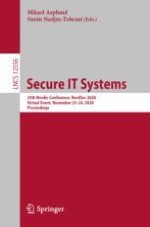2021 | Book
Secure IT Systems
25th Nordic Conference, NordSec 2020, Virtual Event, November 23–24, 2020, Proceedings
Editors: Dr. Mikael Asplund, Simin Nadjm-Tehrani
Publisher: Springer International Publishing
Book Series : Lecture Notes in Computer Science
